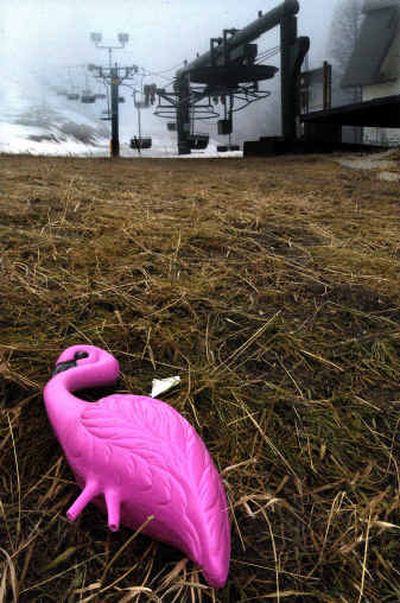Early melt bad news for skiers, rivers

Veteran skier Rob Crick believes this winter is shaping up as one of the worst for winter sports that he’s experienced since he first went to Mount Spokane in 1958.
But like many others concerned about the amount of snow in the mountains, he’s not giving up.
“Is winter over? I just can’t believe it is,” Crick said. “It is still January. We have a lot of winter left.”
Ski resorts aren’t the only ones affected by the dwindling snowpack.
When there’s less snow in the mountains in the winter, there’s less snow to melt into rivers in the summer. That means less water to carry fish and to create electricity from dams.
Snowpacks already were below average when mild temperatures from the Pacific near Hawaii blew into the Inland Northwest early this week. Higher than normal temperatures will remain at least through the end of next week, said Jeffrey Cote, a National Weather Service meteorologist.
In the average winter in late January, the snow atop Quartz Mountain in Mount Spokane State Park contains as much water as 14 inches of rain. But on Friday, there was snow equal to about 5 1/2 inches of rain, and that was melting, according to the National River Forecast Center in Portland.
Drought conditions are a concern for fish attempting to make their way upstream, as well as other wildlife, said Madonna Luers, a Washington Department of Fish and Wildlife spokeswoman. For instance, as watering holes shrink in the later summer, they attract gnats, which can infect deer with a deadly virus.
“It would definitely have an impact on just about everything because water is the lifeblood,” Luers said.
The river forecast center is predicting lower-than-normal spring and summer river flows throughout the Inland Northwest. In the Clark Fork and Spokane rivers, where Avista Corp. has dams, flow is predicted to be about 77 percent of the average.
Avista can’t save much of the extra water produced from the current thaw for later use because its reservoirs don’t have much capacity, said Avista spokesman Hugh Imhof. Still, if dams can’t produce the needed electricity in the summer or fall, an Avista gas-fired plant in Oregon probably can make up the difference.
“We should have enough generation this year,” Imhof said.
Mt. Spokane Ski and Snowboard Park, Schweitzer Mountain Resort and Silver Mountain Resort closed this week as warm weather melted portions of lower elevation runs to the dirt. Schweitzer, Silver, Lookout Pass Ski Area and 49 Degrees North Mountain Resort will be open today.
Ski hill operators said a January warm-up isn’t unusual. But one that lasts this long is.
“This is a 20-year anomaly from what my experience tells me,” said Ron Nova, general manager at Schweitzer.
Crick said conditions had been great. Then came Monday.
“It was like standing in a tub of water. It was not coming down; it was surrounding you,” Crick said. “At the lower elevations, it just took the snow right off.”
But it could be worse. In 1977, Mt. Spokane shut down operations in January and February because of a lack of snow. When it was able to open, it operated on a limited basis with marginal conditions until mid-March, when it finally got relief from a snowstorm.
“Things can change quickly,” Nova said. “A little bit of snow can go a long way.”